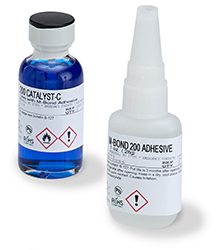Precision Bonding with Strain Gage Adhesives | Micro-Measurements
Achieve optimal performance and durability for your strain gages with Micro-Measurements' high-quality adhesives, including our industry-leading M-Bond line. Proper bonding is essential for accurate strain measurement, and using the right adhesive can make all the difference. Whether you’re working in aerospace, automotive, industrial, or OEM applications, our adhesives ensure secure, long-lasting bonds that maintain the precision of your measurements, even in demanding conditions.
Why Choose Micro-Measurements Adhesives for Strain Gages?
Our strain gage adhesives are specifically formulated to meet the unique demands of stress analysis applications. Generic adhesives often fail to provide the stability and durability needed for strain gage bonding, leading to compromised data accuracy and sensor longevity. With Micro-Measurements, you can be confident that your strain gages are bonded securely, ensuring precise data collection for critical projects.

Key Features of Micro-Measurements Strain Gage Adhesives:
- Superior Bonding Strength: Our M-Bond adhesives deliver robust adhesion, ensuring that strain gages remain securely attached to a variety of surfaces, from metals to composites.
- Temperature Resilience: Designed to withstand a wide range of temperatures, making them ideal for environments with fluctuating or extreme conditions.
- Fast Curing Options: Choose from quick-setting adhesives for rapid installations or long-working-time options for more complex applications.
- Moisture and Chemical Resistance: Our adhesives provide excellent protection against moisture and chemicals, extending the life of strain gage installations in harsh environments.
- Easy Application: Our adhesives are user-friendly, simplifying the bonding process while ensuring consistent results every time.
Industry Applications for Strain Gage Adhesives
In aerospace applications, where precision and reliability are paramount, our M-Bond adhesives provide a secure bond for strain gages on critical components like wings, fuselage sections, and landing gear. These adhesives ensure accurate data collection throughout rigorous testing and operational conditions. Similarly, in the automotive industry, engineers depend on our strain gage adhesives to bond gages to vehicle components such as chassis and suspension systems. The robust adhesion and temperature stability of M-Bond products ensure that strain gages deliver precise data, even under high-speed and high-temperature conditions.
For industrial applications, our strain gage adhesives are used to bond sensors to machinery and structural components, ensuring reliable performance during stress and fatigue testing. Their moisture-resistant properties make them ideal for use in humid or chemical-rich environments. In OEM manufacturing, precision bonding is essential to producing high-quality, reliable sensors. Our adhesives are specifically formulated to integrate seamlessly into production processes, ensuring consistent performance and accuracy over the equipment's lifespan.
For Our Full Range of Strain Gage Adhesives
Strain Gage Adhesives Chart
| | -500 F | | -320 F | | -150 F | | +32 F | | +200 F | | +400 F | | +575 F | | +750 F | |||||||||||||||||||||||||||||||||||||||||||||
|
Room |
M-BOND 200 | | | | | | | | | | | | | | | ||||||||||||||||||||||||||||||||||||||||||||
| | | | | | | | | | | | | | | | | |||||||||||||||||||||||||||||||||||||||||||||
| M-BOND AE-10 | | | | | | | | | ||||||||||||||||||||||||||||||||||||||||||||||||
| | | | | | | | | | | | | | | | | |||||||||||||||||||||||||||||||||||||||||||||
| M-BOND GA-2 | | | | | | | | | | | |||||||||||||||||||||||||||||||||||||||||||||||
| | | | | | | | | | | | | | | | | |||||||||||||||||||||||||||||||||||||||||||||
| M-BOND A-12 | | | | | | | | | | | | | | | |||||||||||||||||||||||||||||||||||||||||||||
| | | | | | | | | | | | | | | | | |||||||||||||||||||||||||||||||||||||||||||||
| M-BOND 300 | | | | | | | | | | | | | ||||||||||||||||||||||||||||||||||||||||||||||
| | | | | | | | | | | | | | | | | |||||||||||||||||||||||||||||||||||||||||||||
| RTC-2 | | | | | | | | | | | |||||||||||||||||||||||||||||||||||||||||||||||
| | | | | | | | | | | | | | | | | |||||||||||||||||||||||||||||||||||||||||||||
| | -300 C | | -200 C | | -100 C | | 0 C | | +100 C | | +200 C | | +300 C | | +400 C | |||||||||||||||||||||||||||||||||||||||||||||
|
|
|
|
|
|
||||||||||||||||||||||||||||||||||||||||||||||||
| | -500 F |
|
|
|
|
|
| +575 F | | +750 F | |||||||||||||||||||||||||||||||||||||||||||||
|
Elevated |
M-BOND 610 | | | | | | | | | |||||||||||||||||||||||||||||||||||||||||||||||
| | | | | | | | | | | | | | | | | | | ||||||||||||||||||||||||||||||||||||||||||||
| M-BOND 600 | | | | | | | | | ||||||||||||||||||||||||||||||||||||||||||||||||
| | | | | | | | | | | | | | | | | | | ||||||||||||||||||||||||||||||||||||||||||||
| M-BOND 43-B | | | | | | | | | | | | | ||||||||||||||||||||||||||||||||||||||||||||||
| | | | | | | | | | | | | | | | | | | ||||||||||||||||||||||||||||||||||||||||||||
| M-BOND 450 | | | | | | | | | ||||||||||||||||||||||||||||||||||||||||||||||||
| | | | | | | | | | | | | | | | | | | ||||||||||||||||||||||||||||||||||||||||||||
| M-BOND AE-15 | | | | | | | | | | | | | ||||||||||||||||||||||||||||||||||||||||||||||
| | | | | | | | | | | | | | | | | |||||||||||||||||||||||||||||||||||||||||||||
| M-BOND GA-61 | | | | | | | | | | | | | ||||||||||||||||||||||||||||||||||||||||||||||
| | | | | | | | | | | | | | | | | |||||||||||||||||||||||||||||||||||||||||||||
| DENEX #3 | | | | | | | | | ||||||||||||||||||||||||||||||||||||||||||||||||
| | | | | | | | | | | | | | | | | |||||||||||||||||||||||||||||||||||||||||||||
| EPOXYLITE 813 | | | | | | | |||||||||||||||||||||||||||||||||||||||||||||||||
| | | | | | | | | | | | | | | | | |||||||||||||||||||||||||||||||||||||||||||||
| P ADHESIVE | | | | | | | |||||||||||||||||||||||||||||||||||||||||||||||||
| | | | | | | | | | | | | | | | | |||||||||||||||||||||||||||||||||||||||||||||
| QA-500 | | | | | | | | | ||||||||||||||||||||||||||||||||||||||||||||||||
| | | | | | | | | | | | | | | | | |||||||||||||||||||||||||||||||||||||||||||||
| EPY-500 | | | | | | | | | ||||||||||||||||||||||||||||||||||||||||||||||||
| | | | | | | | | | | | | | | | | |||||||||||||||||||||||||||||||||||||||||||||
| | -300 C | | -200 C | | -100 C | 0 C | +100 C | +200 C | +300 C | +400 C | |||||||||||||||||||||||||||||||||||||||||||||
Strain Gage Adhesives List
| M-BOND 200 | Most widely used general-purpose adhesive. Easiest to handle. Fast room-temperature curing. | |
| M-BOND AE-10 | General-purpose adhesive that is highly resistant to moisture and most chemicals. Room-temperature curing. | |
| M-BOND AE-15 | Similar to AE-10. Recommended for more critical applications, including transducer gaging. Moderately elevated-temperature curing. | |
| M-BOND 610 | Used primarily in stress analysis applications over a wide temperature range, and in precision transducers. Elevated-temperature curing. | |
| M-BOND 600 | Similar to 610, but faster reacting. Can be cured at somewhat lower temperatures than 610. | |
| M-BOND 43b | Normally used in precision transducers. Highly resistant to moisture and chemical attack. Elevated-temperature curing. | |
| M-BOND GA-2 | Special-purpose adhesive primarily used on very rough and irregular surfaces. Room-temperature curing. | |
| M-BOND GA-61 | Special-purpose adhesive with a higher operating temperature range than GA-2, and more viscous. Also used to fill irregular surfaces and to anchor leadwires. Elevated-temperature curing. | |
| M-BOND A-12 | Special-purpose, very high-elongation adhesive. Used only when other adhesives cannot meet elongation requirements. Elevated-temperature curing. |
Ceramic Adhesives
At extremely high temperatures, all insulating materials suffer from a decline in their insulating properties. Ceramic cements, while very robust at elevated temperature, also exhibit this characteristic. While the reduction in insulation resistance to ground is not permanent, it does decline to the point where it will influence signal stability and accuracy. The effectiveness of the cement as an insulator is under the direct control of the installer. The thickness and consistency of the base coat, which becomes the “backing” for the free filament strain gage, is critical to the quality of the installation.
Additionally, this layer is the media, which transmits strain from the test article to the strain gage filament. If the layer is too thick, it will crack when strained. If it is too thin, the insulation resistance to ground will be insufficient at elevated temperature. The ideal base coat thickness is 0.003”. When properly installed, some of the free filament gages can collect valid data to 2100°F and under ideal conditions; data can be recorded at even higher temperatures. It is incumbent upon the technician / engineer to develop the necessary skill set to make the installation and to verify the installation quality before taking data.
Ceramic Adhesives Chart
| | -500 F | | -320 F | | -150 F | | +32 F | | +200 F | | +400 F | | +575 F | | +750 F | | +930 F | | +1,100 F | | +1,300 F | | +1,475 F | | +1,650 F | | +1,800 F | |||||||||||||||
| | | | | | | | | | | | | | | | | | | | | | | | | | | ||||||||||||||||
| GC CEMENT | | | | | ||||||||||||||||||||||||||
| | | | | | | | | | | | | | | | | | | | | | | | | | | | | |||||||||||||||
| PBX CEMENT | | | | | | | | | | | |||||||||||||||||||||||
| | | | | | | | | | | | | | | | | | | | | | | | | | | | | |||||||||||||||
| SAUREISEN #8 CEMENT | | | | | ||||||||||||||||||||||||||
| | | | | | | | | | | | | | | | | | | | | | | | | | | | | |||||||||||||||
| H Cement | | | | | ||||||||||||||||||||||||||
| | | | | | | | | | | | | | | | | | | | | | | | | | | | | |||||||||||||||
| HG-1 (TEC of steel) | | | | | | | | | ||||||||||||||||||||||||
| | | | | | | | | | | | | | | | | | | | | | | | | | | | | |||||||||||||||
| NCC-3 | | | | | | | | | ||||||||||||||||||||||||
| | | | | | | | | | | | | | | | | | | | | | | | | | | | | |||||||||||||||
| WC-16 (low TEC) | | | | | | | | | ||||||||||||||||||||||||
| | | | | | | | | | | | | | | | | | | | | | | | | | | | | |||||||||||||||
| -300 C | -200 C | -100 C | 0 C | +100 C | +200 C | +300 C | +400 C | +500 C | +600 C | +700 C | +800 C | +900 C | +1,000 C | |||||||||||||||
Ceramic Adhesive List
| EPOXYLITE 813 | Used for long term, high temperature applications requ | |
| P ADHESIVE | Single-part solvent thinned polyimide adhesive. Excellent for long-term high temperature applications. | |
| GC CEMENT | Single-part ceramic cement used for free-filament gages. Recommended for use on low TCE materials, such as carbon. | |
| PBX CEMENT | Two-part ceramic cement/coating used for free-filament strain gages. Good adhesion to most metals. | |
| SAUREISEN #8 CEMENT | Single-part chemical setting zircon-based cement used for free-filament strain gages. High electrical insulation and thermal conductivity. |
Ready to Upgrade Your Strain Gage Bonding?
Contact us today to learn how Micro-Measurements' M-Bond and other strain gage adhesives can enhance the performance of your stress analysis projects. Request a demo, visit our product guide, or speak to a specialist to find the right adhesive for your specific needs. Let us help you achieve precision bonding for better results.
Contact Our Strain Gage Adhesives Experts

VIDEOS
Explore our extensive collection of tutorials and informational videos on a variety of strain measurement topics.

STRAINTALKS
Explore our free education seminars aimed at helping Design and Test Engineers understand strain gage theory selection, preparation, performance, installation, configuration, and more.

STRAINBLOG
Questions and answers on the go! Listen to Micro-Measurements experts explain the many facets of strain gage technology.

TRAINING
Benefit from an extensive series of regularly scheduled, hands-on technical workshops and short courses.




